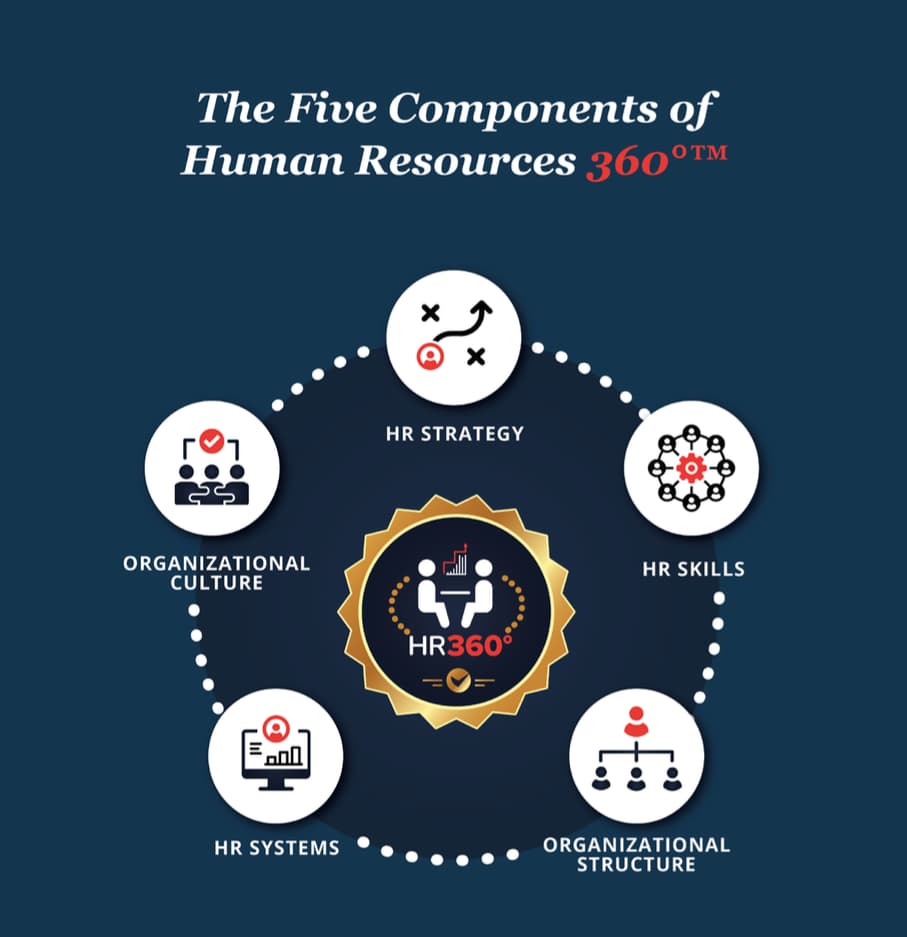
As a fractional Chief Human Resources Officer (CHRO), I have collaborated with CEOs across numerous sectors to diagnose and resolve human resource problems. The work is rewarding, but the issues can be incredibly damaging and costly to unravel. Therefore, I often recommend that my clients strengthen their HR infrastructures to avoid future complications. Below, I explain what a human resource infrastructure is, why it matters, and its essential components so growing companies can be more proactive.
What Is HR Infrastructure?
Human resource infrastructure is the underlying value system and corresponding practices, processes, and systems that enable you to hire, motivate, and retain the right people for your environment so you can achieve your business goals. In other words, it is the foundation your team needs to do their best work and help you achieve your vision.
Every company needs a strong foundation of back-office functions and standard operating procedures. However, while most CEOs understand that accounting, finance, and payroll are non-negotiable, many see human resources as “nice to have.” And that’s where the problems start.
People comprise your business, so the moment you start a company, you begin to develop a human resources infrastructure. However, if you allow that to happen organically, this vital back-office function can become dysfunctional – leading to cost issues, tax concerns, legal challenges, hiring problems, employee attrition, and more. So, instead, we encourage our clients to build their HR infrastructures intentionally, alongside their business plans, and to keep them in sync – empowering them to create a financially sound and scalable business.
The No-BS Financial Playbook for Small Business CEOs
Are you tired of making costly financial mistakes? Stop guessing and start growing. Learn how to create a scalable and valuable company while minimizing risk with this playbook from a serial entrepreneur who has been in your shoes.
Why Does Human Resources Infrastructure Matter?
A good HR Infrastructure sets the stage for how your company will hire and interact with the people who make your work possible and how they will interact with each other. We understand that may sound like overkill when your business is just starting, but CEOs must look to the future. As your company grows and scales, you will need clarity and efficiency across the board.
For example, if you manufacture and sell products, you undoubtedly know that you need a network of reliable suppliers, a well-run manufacturing process, quality control, and distribution channels. But that’s only half the battle. You also need a great team of motivated people to do that work, which requires a different strategic perspective.
To build a top-notch team, you must develop the following:
- A firm understanding of the roles you must fill and when you need them.
- A strong reputation as an employer so you can hire.
- A healthy company culture where employees feel connected, engaged, and safe.
- Hiring and employment practices that comply with laws and regulations.
- A scalable HR department to create systems, processes, and hiring and training programs appropriate to your needs.
And that’s just to start, but don’t worry—you don’t have to do it all at once. You can build these things over time by taking inventory of your human resource function’s strengths and weaknesses and then prioritizing items that allow you to pursue your goals while mitigating risk.
The 5 Components of HR Infrastructure

When determining how to build an HR infrastructure appropriate to your environment, it helps to have a framework to guide your thinking. At The CEO’s Right Hand, we review your situation through the lens of 5 key components. I briefly explain each one below, but for deeper insights, examples, and an HR infrastructure checklist for self-assessment, consider downloading our HR Infrastructure 360°™ guide.
HR Strategy
Strategic human resource management, or planning and management, is a process that allows for the diagnosis and alignment of your organization’s strategy, structure, systems, and skills. It is a collaborative, executive-level effort that involves:
Human Resource Infrastructure 360°™
Don’t let costly human resource issues creep up on you. Learn about the 5 components of HR Infrastructure 360°™ - our proprietary framework for building and supporting your team.
- Clarifying your business strategy and goals
- Reviewing your HR capabilities through that lens
- Developing, prioritizing, and implementing plans appropriate to your company’s growth stage
- Result tracking and iteration
Put differently, your HR strategy is the blueprint for how and when your human resource function will evolve. The HR infrastructure checklist I mentioned above can help with step two.
Human Resource Skills
Building HR infrastructure requires specific skills, but each company’s needs will vary. So, when developing this component, you will take inventory of your HR team’s abilities and establish a plan to fill in the gaps.
For instance, small to mid-sized companies often need strategic HR advice but may not be ready for a full-time CHRO. In that case, hiring a fractional CHRO could be perfect – they can work with your executive team to craft your HR strategy and hire the people you need to build your infrastructure and manage the day-to-day.
Organizational Structure
Growing, scaling, and supporting your entire team as your company evolves while minding your budget is no small task. To do so effectively, you need a sound organizational structure – a documented system for hiring employees and providing them with the support they need to do their work. That involves looking at your business holistically and determining how to answer questions like the following:
- What roles and responsibilities do we need for each team, and when will we need them to achieve our objectives?
- How should we structure our teams and coordinate their work to avoid inefficiencies?
- What compensation strategy is appropriate to our business?
- What systems do we need for performance management and professional development?
- How can we best hire, onboard, train, and nurture people – encouraging employee engagement and success?
HR Systems
The right technology and support can make it easier to manage a growing team. Yet, you must choose solutions appropriate to your needs to avoid excess cost and complexity. For example, many small companies start with a simple payroll solution like QuickBooks. However, more sophisticated capabilities quickly become necessary as organizations grow, acquire technology, and expand into other regions.
Moving from one system to another can be tricky. So, when the time comes, consider hiring an experienced HR professional to review your situation, recommend solutions, and help you set them up.
Organizational Culture

Anytime people interact regularly in a social setting, a culture develops. Therefore, every business has an organizational culture – a shared set of values, norms, and behaviors that shape the employee experience and the company’s reputation. That, in turn, can affect your ability to attract, hire, and keep the employees you need to run your business.
You can build an organizational culture intentionally or just let it happen. Yet, if you don’t take control, you may find yourself with a chaotic or even toxic culture that bears little resemblance to what you originally had in mind. Therefore, we recommend that you be proactive. Determine what you want, then establish behavioral guidelines and hold everyone (including your executives) accountable for adhering to them.
How Do You Know You Have an Infrastructure Problem?
HR infrastructure issues are avoidable with proper planning. Yet, they can sneak up on you, so you must learn to spot subtle signs that something is amiss before the situation gets out of control. Here are a few examples of things to look for:
- Uncertainty or inconsistencies among your management team when handling routine employee issues like grievances, vacation or medical leave, or resource requests.
- Rapid growth into new regions without a clear vision of how that will affect your policies, comp plans, organizational structures, or budget.
- A management team that is laser-focused on achieving its business goals but doesn’t advocate for processes, controls, or systems to improve team cohesiveness.
- A pattern of hiring promising and productive employees who later become stressed, less effective, and disengaged.
- A disconnect between your stated mission and values and your reputation.
These issues may seem minor in isolation. But, over time, they can lead to inefficiencies, hiring and retention challenges, legal compliance concerns, and even lawsuits.
Human Resources Infrastructure: The Bottom Line
You need a team of skilled and motivated employees to build a thriving business that can grow, scale, and deliver value. But hiring is expensive, so you also need to create and support that team in a financially responsible way. Developing a solid HR infrastructure that is in sync with your business plans is the best way to accomplish that. Download the HR Infrastructure 360°™ guide to learn more.





